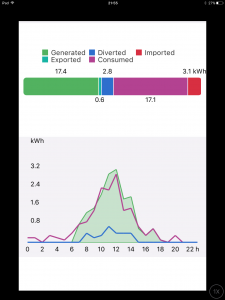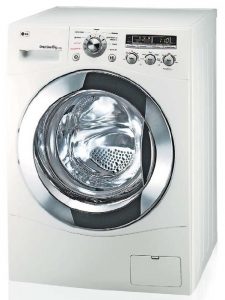This week I was discussing how to maximise the benefit of self-consumption with an installer. The issue here is, where one has multiple independent systems (such as a battery and a water heater) each looking to use any surplus self-generated electricity, how does one set the priorities of the devices or is it just a lottery which gets the surplus power first? In my own case, for example, I recognise that the surplus invested in my battery storage is better value than investing that surplus in hot water as electricity is considerably more expensive than gas.
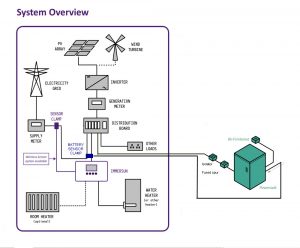 I have previously written on this subject Prioritising the battery, but the installer was unaware of my solution and recommended an alternative which I consider flawed. The solution recommended by the installer is to enter the maximum charging power of the battery as the export threshold in the ImmerSUN controller. This does indeed create headroom for the battery to charge, but I believe does not use the ImmerSUN to best advantage. Let me use a table to contrast what might happen at 3kW generation with both the installer’s and my own solutions:
I have previously written on this subject Prioritising the battery, but the installer was unaware of my solution and recommended an alternative which I consider flawed. The solution recommended by the installer is to enter the maximum charging power of the battery as the export threshold in the ImmerSUN controller. This does indeed create headroom for the battery to charge, but I believe does not use the ImmerSUN to best advantage. Let me use a table to contrast what might happen at 3kW generation with both the installer’s and my own solutions:
| Installer's solution | My solution |
| Baseload of house | 0.2 kW | 0.2 kW |
| ImmerSUN Export threshold | 0.8 kW | - |
| Battery charging | 0.8 kW | 0.8 kW |
| Balance for water heating | 1.2 kW | 2.0 kW |
| Total load / total generation | 3.0 kW | 3.0 kW |
The installer’s solution will potentially always waste an amount of power equal to the maximum battery charge power / ImmerSUN export threshold. My solution doesn’t do this, although there is an aspect of immersion heater operation that may or may not concern you.
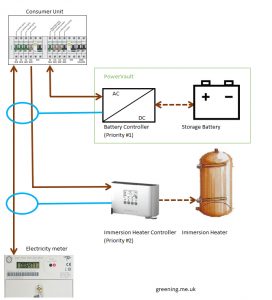 In my scheme I modify use of the current clamp for the priority device – the battery for me. Such current clamps have the property of summing the current in all the cables which they surround and, as you’ll see from the pictures, my control clamp for the battery surrounds both the incoming power cable from the grid and the outgoing cable to the immersion heater.
In my scheme I modify use of the current clamp for the priority device – the battery for me. Such current clamps have the property of summing the current in all the cables which they surround and, as you’ll see from the pictures, my control clamp for the battery surrounds both the incoming power cable from the grid and the outgoing cable to the immersion heater.
The effect of this arrangement leaves the ImmerSUN acting normally – it sees any export and diverts it to hot water.
The current clamp for battery however sees the sum of the export current and the current diverted to the immersion heater, so it doesn’t matter how much the ImmerSUN diverts (and thus reduces the export) – the battery ‘sees’ what would have been exported without the ImmerSUN and responds according.
The ImmerSUN clamp then ‘sees’ the export current drop as the battery charge current increases and thus reduces its own current proportionately.
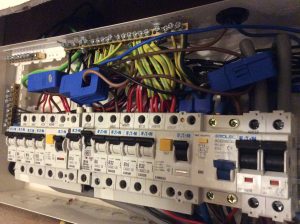 To gain access to both the incoming live mains supply cable and the outgoing live feed to the immersion heater, my current clamp is located within the consumer unit. It’s the blue clamp on the right around the larger incoming cable and the smaller brown cable for the immersion heater. You need to be a competent person to work inside a consumer unit. (There are two further blue clamps to the left but their function isn’t relevant to this post.)
To gain access to both the incoming live mains supply cable and the outgoing live feed to the immersion heater, my current clamp is located within the consumer unit. It’s the blue clamp on the right around the larger incoming cable and the smaller brown cable for the immersion heater. You need to be a competent person to work inside a consumer unit. (There are two further blue clamps to the left but their function isn’t relevant to this post.)
The aspect of this that may concern you (but doesn’t bother me) occurs if you want to run the immersion heater from stored electricity rather than just using surplus from the solar panels immediately. If you turn on the immersion heater using the Immersun (known as ‘boosting’ in ImmerSUN vocabulary) then the current from the consumer unit to the immersion heater is equal and opposite to the current from the grid to the consumer unit, which is summed by the battery’s current clamp to zero and thus the battery neither ‘sees’ that current nor discharges to meet that load. To me this isn’t an issue as I consider transferring energy stored in one device (a battery) to another storage device (a hot water cylinder) is poor practice; and in any case the battery doesn’t have enough power capability (maximum 1.2 kW) to run the immersion heater at full load (3 kW) so you’d always be importing at least 1.8 kW to run the immersion heater.
As a final note – it is critical to orientate the two cables in the battery’s current clamp correctly for the system to work as intended. Current from the consumer unit to the grid, and from the consumer unit to the immersion heater, must flow in the same direction through the battery’s clamp.
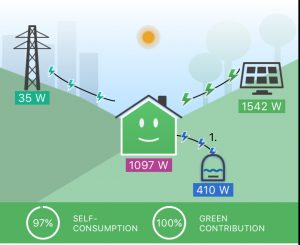 Here we have the system in action earlier today. With 1542 Watts coming from the solar panels, the house (including the PowerVault storage battery) is running at a maximum of 1097 Watts, with the balance of the available power controlled by the ImmerSUN- 410 Watts to water heating and at the point of this snapshot 35 Watts into the grid. At this moment that’s 97% of generation used as such self-consumption and 100% of energy being consumed coming from the solar panels.
Here we have the system in action earlier today. With 1542 Watts coming from the solar panels, the house (including the PowerVault storage battery) is running at a maximum of 1097 Watts, with the balance of the available power controlled by the ImmerSUN- 410 Watts to water heating and at the point of this snapshot 35 Watts into the grid. At this moment that’s 97% of generation used as such self-consumption and 100% of energy being consumed coming from the solar panels.

